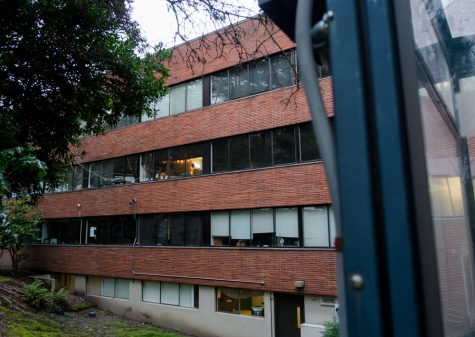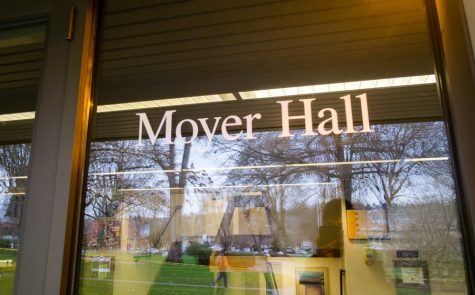Something in the air
Despite inspection for mold in Moyer Hall, former resident’s asthma aggravated by living there
February 12, 2020
Daniella Muhlebach woke up nearly every morning last quarter gasping for breath. She was having an asthma attack. Instead of a basic inhaler, Muhlebach had to use her nebulizer to treat the attacks.
“It’s what they give you at the hospital when I don’t have time to get to the hospital. I have one just in case,” Muhlebach said. “I had to use that every time.”
But she was not surprised. She knew before she had unpacked her bags in September that she would not do well in Moyer hall.
“The first day, before anything was even unpacked, already I had breathing issues in the dorm,” Muhlebach said. “Even my family and my boyfriend, who don’t have breathing problems, had problems in the dorm.”
When Muhlebach and her roommate received their room assignment this summer, she suspected immediately that an older building might trigger her asthma and allergies. As Moyer is the campus’ oldest dorm, she worried about dust and the potential for mold.

Moyer Hall, the oldest dorm on campus, has a reputation for causing higher rates of sickness among students.
“So I had to email [campus housing] saying ‘listen I have very severe asthma and allergies and I don’t do well in old buildings, I can’t be in an old building,’” Muhlebach said.
But she was not moved to a different dorm until the end of last quarter, months after her trouble breathing escalated. As soon as she moved into her new room in Emerson, the asthma and allergies exacerbated by the old room declined dramatically.
She had been right, she realized. The conditions in Moyer created the problem.
Her asthma attacks increased throughout the fall quarter she lived in Moyer. All the while, she tried to get the attention of Disability Support Services (DSS) and housing. She knew something in Moyer was causing her health conditions to flare up.
“Over the course of the quarter that I was there, I had asthma attacks three to four times per week in the dorm, when I wasn’t doing anything that would ordinarily cause one,” Muhlebach said.
“That is not normal for me.”
“Daniella would wake up almost every morning with an asthma attack,” Ana Julian, Muhlebach’s former roommate in Moyer, recalled. “And she’d wake me up with her breathing issues.”
Over the summer, Muhlebach was given a disability form to file with the university. But when she tried to bring it to her breathing specialist in San Francisco, they realized there was nowhere to write “asthma.”
“The questions seemed more wheelchair based,” Muhlebach explained.
She was unable to complete the form, so she started to email DSS and Residence Life Coordinators.
DSS asked for proof of her disability and a completed form, which she said she struggled to complete because her specialist insisted the form did not include a section for breathing issues like asthma and allergies.
In the meantime, she waited and lived in the room. Muhlebach did everything she could to be able to breath somewhat normally. She cleaned the room constantly. She made sure to capture every particle of dust. The room was as clean as she could make it. But nothing worked.
She spoke to her RA when she noticed strange markings on the carpet near her central heating unit and on the ceiling, which worried her about water damage, mold and mildew.
Her RA filed a report, and building analysts came out to inspect the room.

Moyer Hall was inspected for health hazards such as mold by a third party industrial hygienist, who found no health hazards.
According to Director of Residence Life Gabe Jacobson, this is the protocol for complaints made by students.
“Anytime we get the concerns, we do have someone coming in,” Jacobson said. “We always work with a third party industrial hygienist.”
Anytime they find any issue, he said, they give a full report to facilities. According to Jacobson, he has never seen facilities fail to complete the list of recommendations.
Additionally, in response to the reputation Moyer has among some students for making its residents sick more often than other buildings, he said that buildings are regularly checked for air quality.
“[There are] full scale assessments of the materials in the building — taking air quality samples. There’s a lot that goes into it.”
The analysts told Muhlebach that there was no mold in her room. The mark on the ground was from fixing the carpet, and the stain on the ceiling was water damage from a leak in the roof.
“They didn’t find any mold but they tried to pin it on me a bit, saying things like ‘maybe you don’t clean your room as much,’” Muhlebach said. “Then they inspected my room and they were like ‘this is the cleanest dorm room I’ve seen.’”
Despite the inspection and Muhlebach’s efforts, however, she and Julian— who also has asthma — were unable to breathe well in the room.
“It was always musty in the room, we had a dehumidifier and an air purifier but the air felt super gross and we had to keep windows open to breathe,” Julian said.
She was finally able to move rooms at the end of the quarter, after she was informed of a change in policy which allowed students to change rooms on the first request.
Her breathing issues have significantly decreased since she moved to Emerson and she is grateful to be able to breathe easily in her new room.
“I just wanted to get out of there as quickly as possible,” she said. “I think part of it was the fact that I had been talking about this since summer trying to get it changed for so long…”



























































































